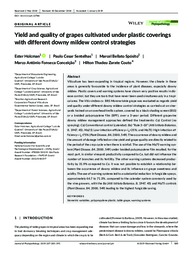Yield and quality of grapes cultivated under plastic coverings with different downy mildew control strategies.
Yield and quality of grapes cultivated under plastic coverings with different downy mildew control strategies.
Author(s): HOLCMAN, E.; SENTELHAS, P. C.; SPÓSITO, M. B.; CONCEIÇÃO, M. A. F.; COUTO, H. T. Z.
Summary: Viticulture has been expanding in tropical regions. However, the climate in these areas is generally favourable to the incidence of plant diseases, especially downy mildew. Plastic covers and warning systems have shown very positive results in disease control, but they are tools that have never been used simultaneously in a tropical area. The Vitis vinifera cv. BRS Morena table grape was evaluated as regards yield and quality under different downy mildew control strategies as carried out on vineyards trained on an overhead trellis system, covered by a black shading screen (BSS) or a braided polypropylene film (BPF), over a 3?year period. Different grapevine downy mildew management approaches defined the treatments: Co) Control (no spraying); Ca) Conventional control (calendar); Ba) “Rule 3–10” (Atti Istituto Botanico, 8, 1947, 45); Ma25) Low?infection efficiency—i0>25%; and Ma75) High?infection efficiency—i0>75% (Plant Disease, 84, 2000, 549). The occurrence of downy mildew and the amount of damage inflicted on vine yield and grape quality are directly related to the period of the crop cycle when there is rainfall. The use of the Ma75 warning system (Plant Disease, 84, 2000, 549) under braided polypropylene film resulted, for the most part, in similar vineyard productivity compared to Ca, but did not influence the number of branches and its fertility. The other warning systems decreased productivity by 31.9% compared to Ca. It was not possible to establish a relationship between the occurrence of downy mildew and its influence on grape sweetness and acidity. The use of warning systems led to a substantial reduction in fungicide sprays, approximately 66.7 to 71.3%, compared to the calendar system commonly used by the vine growers, with the Ba (Atti Istituto Botanico, 8, 1947, 45) and Ma75 controls (Plant Disease, 84, 2000, 549) leading to the highest fungicide saving. KEYWORDS biometric variables, polypropylene plastic, table grape, warning systems
Publication year: 2019
Types of publication: Journal article
Unit: Embrapa Grape & Wine
Observation
Some of Embrapa's publications are published as ePub files. To read them, use or download one of the following free software options to your computer or mobile device. Android: Google Play Books; IOS: iBooks; Windows and Linux: Calibre.
Access other publications
Access the Agricultural Research Database (BDPA) to consult Embrapa's full library collection and records.
Visit Embrapa Bookstore to purchase books and other publications sold by Embrapa.

